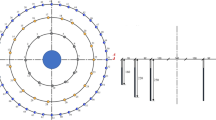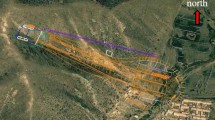Abstract
Blast-induced vibration with non-stationary behavior needs specific tools to be analyzed. We explore the capability of wavelet analysis to investigate the blast-induced vibration characteristic of a dam in China. Velocity sensors are installed on the bedrock as well as the crest to record particle vibration response subject to an adjacent tunnel blasting. Finite element method (FEM) is adopted to determine the natural frequencies and mode shapes of the dam, as well as the time-history dynamic response. The continuous wavelet transform and discrete wavelet multi-resolution analysis enable us to characterize the peak particle velocity (PPV), spectral energy and vibration duration more specifically. Cross wavelet transform and wavelet coherence present the advantage to give the common power and phase-locked behavior between bedrock records and crest records. No evidence of resonance is found in the phase relations where the dam’s natural frequency is located. All the results including FEM, PPV, spectral energy and displacements are matching and indicate that the dam is in the undamaged state.









Similar content being viewed by others
References
Skipp BO (1998) Ground dynamics and man-made processes: prediction, design and management. Thomas Telford, London
Wu Y, Hao H, Zhou Y, Chong K (1998) Propagation characteristics of blast-induced shock waves in a jointed rock mass. Soil Dyn Earthq Eng 17(6):407–412
Jiang N, Zhou C (2012) Blasting vibration safety criterion for a tunnel liner structure. Tunn Undergr Space Technol 32:52–57
Edwards AT, Northwood T (1960) Experimental studies of the effects of blasting on structures. Engineer 210:538–546
Mohamed M (2010) Vibration control. In: Mickaël Lallart (ed) Vibration Control, Sciyo, Croatia, pp 380. Available from: http://www.intechopen.com/books/vibration-control/vibration-control
Skipp BO (1984) Dynamic ground movements-man-made vibrations. Ground movements and their effects on structures. Surrey University Press, London
Siskind DE, Stagg MS, Kopp JW, Dowding CH (1980) structure response and damage produced by ground vibration from surface mine blasting. US Bureau of Mines: USBM Report of Investigations 8507
Tao L, Yu Y (2012) Research of three key issues on safety standards of blasting vibration. Metal Mine 10:127–129
Deutsches Institut Fur Normung (1999) Vibration in buildings-Part 3: effects on structures (DIN 4150-3), Berlin, Germany
British Standard Institution (1990) Evaluation and measurement for vibration in buildings, guide for measurement of vibrations and evaluation of their effects on buildings (BS 7385-1). BSI, London
Hamidi B, Varaksin S, Nikraz HA (2011) Case of Vibro Compaction Vibration Monitoring in a Reclaimed Site. In: Shahin M, Nikraz H (eds) International conference on advances in geotechnical engineering (ICAGE 2011). Curtin University, Perth, pp 861–866
Tunstall A (1997) Damage to underground excavations from open-pit blasting. Trans Inst Min Metall Sect A Min Ind 106:A19–A24
Athanasopoulos G, Pelekis P (2000) Ground vibrations from sheetpile driving in urban environment: measurements, analysis and effects on buildings and occupants. Soil Dynamics Earthq Eng 19(5):371–387
Jordan J, Sutcliffe DJ, Mullard JA (2009) Blast vibration effects on historical buildings. Aust J Struct Eng 10(1):75–84
Nateghi R, Kiany M, Gholipouri O (2009) Control negative effects of blasting waves on concrete of the structures by analyzing of parameters of ground vibration. Tunn Undergr Space Technol 24(6):608–616
Yang J, Lu W, Jiang Q, Yao C, Zhou C (2016) Frequency comparison of blast-induced vibration per delay for the full-face millisecond delay blasting in underground opening excavation. Tunn Undergr Space Technol 51:189–201
Li H, Shu D, Lu W, Zhu C (2010) Response characteristics of a structure to different frequency components in blasting vibration energy. J Vib Shock 2(29):154–158
Svinkin M (1999) Drawbacks of blast vibration regulations. In: Proceedings of the annual conference on explosives and blasting technique, 2003. ISEE; pp 157–168
Ma G, Hao H, Zhou Y (2000) Assessment of structure damage to blasting induced ground motions. Eng Struct 22(10):1378–1389
Gurley K, Kareem A (1999) Applications of wavelet transforms in earthquake, wind and ocean engineering. Eng Struct 21(2):149–167
Chakraborty A, Okaya D (1995) Frequency-time decomposition of seismic data using wavelet-based methods. Geophysics 60(6):1906–1916
Sinha S, Routh PS, Anno PD, Castagna JP (2005) Spectral decomposition of seismic data with continuous-wavelet transform. Geophysics 70(6):P19–P25
Bayissa WL, Haritos N, Thelandersson S (2006) Structural condition assessment from recorded earthquake response data. In: Australian earthquake engineering society. AEES 2006 conference, Canberra, 24–26 November 2006. pp 77–83
Daubechies I (1992) Ten lectures on wavelets (CBMS-NSF regional conference series. In applied mathematics). SIAM, Philadelphia
Mallat SG (1989) A theory for multiresolution signal decomposition: the wavelet representation. IEEE Trans Pattern Anal Mach Intell 11(7):674–693
Goupillaud P, Grossmann A, Morlet J (1984) Cycle-octave and related transforms in seismic signal analysis. Geoexploration 23(1):85–102
Chui CK (1992) Wavelets: a tutorial in theory and applications. Wavelet Anal Appl 2:345–348
Burrus CS, Gopinath RA, Guo H (1998) Introduction to wavelets and wavelet transforms. Prentice Hall, Upper Saddle River
Torrence C, Compo GP (1998) A practical guide to wavelet analysis. Bull Am Meteorol Soc 79(79):61–78
Torrence C, Webster PJ (1999) Interdecadal changes in the ENSO-monsoon system. J Clim 12(8):2679–2690
Grinsted A, Moore JC, Jevrejeva S (2004) Application of the cross wavelet transform and wavelet coherence to geophysical time series. Nonlinear Process Geophys 11(5/6):561–566
Allen MR, Smith LA (1996) Monte Carlo SSA: detecting irregular oscillations in the presence of colored noise. J Clim 9(12):3373–3404
Deng C, Xu C, Ge G (2012) Modal analysis and wavelet transform in evaluating dam vibration response caused by blasting. J Yangtze River Sci Res Inst 4(29):26–29
Deng C, Ge G, Xu C, Xu X (2011) Time history analysis of blasting vibration of stone masonry arch dam by finite element method. Blasting 28(4):101–104
Standardization Administration of P.R. China (2012) Code for design of masonry structure (GB50003-2001). China Architecture & Building Press, Beijing, China
Kou L, Jin F, Chi F, Wang L (2007) Analysis of prototype dynamic test of concrete arch dams at home and abroad. J Hydroelectr Eng 5(26):31–37
Zeng X, Zha W, Shi H, Li Z (2010) Selection of wavelet basis function in process of time-frequency analysis of earthquake signals using wavelet packet transform. J Seismol Res 33(4):323–328
Standardization Administration of P.R. China (2003) Safety regulations for blasting vibration (GB6722-2003). China Standards Press, Beijing
Mouraux A, Iannetti GD (2008) Across-trial averaging of event-related EEG responses and beyond. Magn Reson Imaging 26(7):1041–1054
Farge M (1992) Wavelet transforms and their applications to turbulence. Annu Rev Fluid Mech 24(1):395–457
Acknowledgments
We thank the editor Farhad Ansari and anonymous reviewers for their comments and suggestions that helped in improving the manuscript. We are grateful to Aslak Grinsted for providing the MATLAB package for performing cross wavelet and wavelet coherence analysis. This study was supported by the Research Project of Department of Water Resources of Zhejiang Province of China (No. RC1303).
Author information
Authors and Affiliations
Corresponding author
Rights and permissions
About this article
Cite this article
Xu, C., Deng, C. Investigating spectral behavior of tunnel blast-induced vibration using wavelet analysis: a case study of a dam in China. J Civil Struct Health Monit 6, 637–647 (2016). https://doi.org/10.1007/s13349-016-0183-6
Received:
Revised:
Accepted:
Published:
Issue Date:
DOI: https://doi.org/10.1007/s13349-016-0183-6




